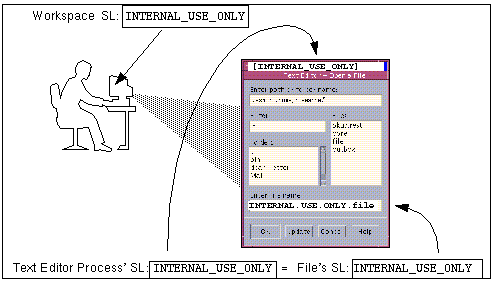Simple Mandatory Access Control Example
If a user brings up a text editor in a workspace with a label of PUBLIC, the process executing the text editor gets the same label as the workspace.
Figure 1-1 shows a comparison between two labels used in making an access control decision. When a user in a workspace with the label INTERNAL_USE_ONLY brings up a text editor, the label of the process running the text editor is automatically set to be equal to the label of the current workspace, and the text editor displays a label of INTERNAL_USE_ONLY. When the text editor attempts to open a file for editing, the label of the process running the text editor is compared to the label of the file. In the example, because the two labels are equal, access for writing is allowed.
Figure 1-1 Comparing the Label of a Text Editor with the Label of a File

If the label of a file is less than that of the text editor, the file can be opened only for reading. (For example, a normal user can use a text editor to open and read a system file at ADMIN_LOW while working at INTERNAL_USE_ONLY, but the text editor cannot save a change to the file. Another consequence of the WURD rule, because of the read down requirement a user cannot see a file whose label is higher than the current working label. However, if a normal user knows the name of a file that has a higher label, the text editor could be used to make a change to the higher-labeled file, even though the user cannot see the file's name.
- © 2010, Oracle Corporation and/or its affiliates
